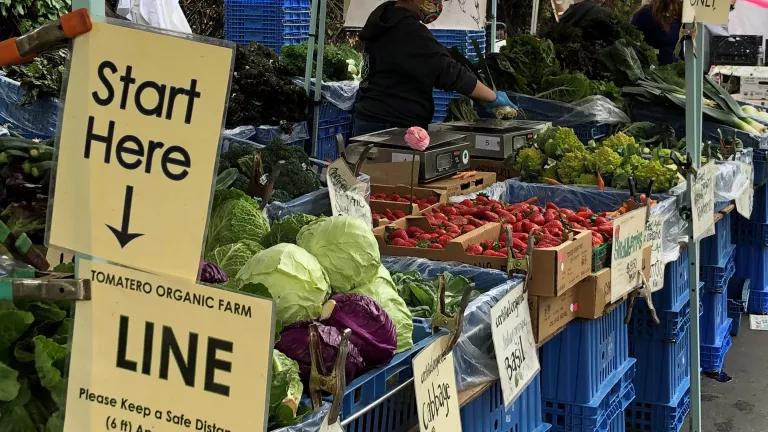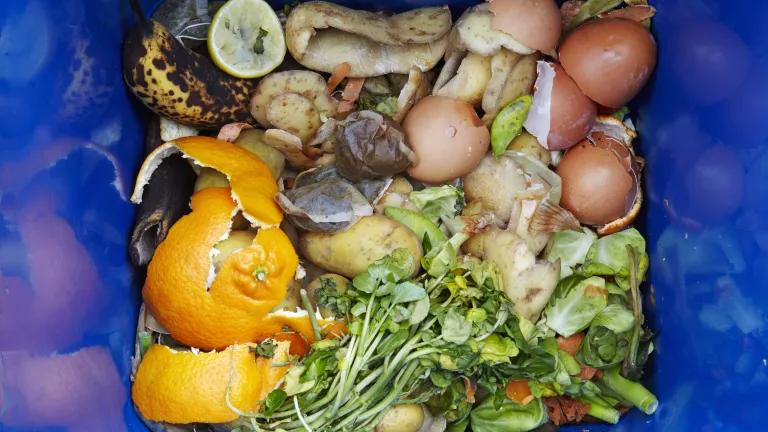Fund Our Farmers So They Continue to Feed Us

Update April 24, 2020: USDA has quietly rolled out the Coronavirus Food Assistance Program, which USDA Secretary Sonny Purdue announced will grant the $9.5 billion from the CARES Act, among other funds, to farmers and ranchers, “regardless of size or market outlet.” Congress’s failure to include mandatory language designating funding for farmers who have lost direct markets was not lost on the Trump Administration; Perdue stated that “we are free to use the $9.5 billion for really all situations” – in other words, USDA believes the CARES Act can be used as just another handout for Big Ag. We urge Congress to rein in USDA’s discretion in the next stimulus package, by explicitly setting aside funds for the small- and mid-sized farmers and ranchers who need help the most.
Small- and mid-sized farms could be among the devastating casualties of the coronavirus pandemic, and with them a critical layer of our nation’s food security and climate resilience. Congress and the Trump Administration need to take immediate action to ensure our local and regional food chains survive. Specifically, Congress should provide additional grants to small and mid-sized farmers. The U.S. Department of Agriculture should also ensure that funds allocated for agriculture in the previous relief package go to the farmers who need it the most.
About half of U.S. farms already lose money every year, and small farms almost universally rely on off-farm income to stay afloat. Small- and mid-sized farms may count on annual sales of under $350,000 or $350,000-$1 million, respectively, but many make far less. Now, farmers who sell primarily at farmers’ markets, restaurants, and other direct markets impacted by the current crisis must essentially rebuild their businesses overnight. A recent economic analysis estimates that from just March to May 2020, food sales to local and regional markets will decline by almost $700 million, leading to a total economic loss of up to $1.32 billion. It’s possible those numbers could grow significantly in the coming months, as impacts of the pandemic on food system workers, transportation, and supply chains pile up.
The third federal stimulus package recognized the unique challenges facing small- and mid-sized farms, but failed to ensure that critical funds will actually end up in their hands. The Coronavirus Aid, Relief, and Economic Security (CARES) Act (S.3548) included two pots of money that the U.S. Department of Agriculture (USDA) can use to help farmers: $9.5 billion in support for producers impacted by coronavirus and a $14 billion increase in funds available to support U.S. agriculture.
Unfortunately, because Congress did not include any meaningful limits on the use of these funds, they may not be reserved for the small- and mid-sized farms that need them most. The CARES Act identifies three groups as intended recipients of the $9.5 billion: specialty crop (i.e. fruits, veggies, nuts) producers; producers that supply local food systems, including farmers markets, restaurants, and schools; and livestock producers, including dairy producers. However, large, consolidated agribusiness organizations have already requested more than $20 billion in aid, and USDA Secretary Sonny Perdue will ultimately decide how to allocate the funds among these groups. This means that smaller farms with limited lobbying power will face an uphill battle to access even a small portion of this funding.
Small- and mid-sized farms protect our food supply, our environment, and our communities. Support for them is also support for rural economies, job security for farm workers, and an investment in a healthier, more resilient food system:
- Over 95 percent of U.S. farms are small- or mid-sized. Collectively, they account for over 40 percent of agricultural production. Without them, the stability of our food supply would be at risk.
- Small- and mid-sized farms play an important role as leaders in organic agriculture and stewards of natural resources. On average, organic farms are small farms. Organic farmers build healthy soil and avoid synthetic pesticides and fertilizers – all practices that protect our climate, resources, and health.
- Small- and mid-sized farms keep rural communities and economies alive. Local-scale farms buy and sell into their local economies and pay proportionally more for labor. In addition, organic farming hotspot counties have been found to have lower poverty rates and higher household income.
- While underrepresented as farm owners, farmers of color are most likely to own small farms. This means that support for small farms equates to more support for farmers of color (though much more must also be done).
- When small- and mid-sized farms struggle financially, the risk of further consolidation in the food system increases. Consolidated power in the food system squeezes the people at both ends of the food chain – the workers and the eaters.
- Small- and mid-sized farms do not traditionally benefit from funds available through Farm Bill commodity and crop insurance programs, according to ongoing NRDC research. These farmers may have no other options.
To ensure that emergency funds are matched with the greatest needs, small- and mid-sized farmers supplying local food systems should have priority access to the $9.5 billion allocated for farm support in the CARES Act. Further, as a step toward offsetting systematic inequities, payments to farmers of color, socially disadvantaged farmers, beginning farmers, and veteran farmers should be double those offered to other eligible farmers. In addition, the next stimulus package should set aside funds specifically and only for these producers. The next relief package should also invest in local and regional distribution systems that connect emergency food providers, schools, and other critical food access points with their local foodsheds.
When our farms and their workforces are healthy—physically, environmentally, and socially—we all benefit. And it’s past time for our public policies to recognize it.





